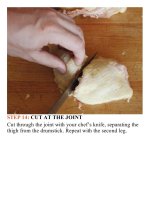The food lab better home cooking through science ( PDFDrive ) 1062
Bạn đang xem bản rút gọn của tài liệu. Xem và tải ngay bản đầy đủ của tài liệu tại đây (226.27 KB, 2 trang )
of oil up to 375°F on your stovetop is a frightening
prospect. But what if I told you that despite the violent
bubbling, alchemic transformation, and incredible
deliciousnessthatresultsfromafry-job-done-well,fryingis
actuallyaremarkablysimpleprocessandoneoftheeasiest
techniques to perform in the kitchen, given a bit of knowhow?
CrispyBeer-BatteredFriedCod(here).
Imean,thinkaboutit:whodoesmostofthedeep-frying
in this country? The least-trained kitchen workers, that’s
who.Whydoyouthinkthefrystationistheveryfirstplace
that most beginning restaurant cooks are assigned to? All
thosefaultlesslyfriedclamsyougetfromroadsideshacksin
New England in the summer—guess who’s cooking them?
Hint:it’snotafour-starchef.Mostlikelyitahighschoolkid
trying to make a few bucks over summer vacation.And if
theycandoit,thensocanyou.
Here’swhathappenswhenyoudropapieceoffoodinto
adeepfryer:
• Dehydration. Free water inside foods and in batters or
breadings will evaporate at 212°F.As soon as your food
hitstheoilinadeepfryer,whichformostrecipesranges
from 300° to 400°F, moisture will rapidly convert into
steam,releasingitselfinaviolentcascadeofbubbles.This
escape of moisture is what you see when you first lower
foodintoafryer.Withinafewminutes(dependingonthe
thickness of your food and temperature of your fryer),
most of the free moisture in your food will have
completely evaporated and the bubbling will slow down.
After this, bound water from inside the food—that is,
water that takes more energy to escape from its cellular
prisons—will continue to be released in small streams of
bubbles.Eventually,afterallfreeandboundmoisturehas
been expelled, you will no longer see bubbles coming
fromyourfood.Atthisstage,yourpotatochipisaboutas
friedasit’sgonnaget.
• Expansion. This phenomenon occurs in foods that are
coated in a batter or dredged in a mixture leavened with
baking powder, whipped egg whites, or other ingredients
that cause the formation of air bubbles. Hot air takes up
more space than cold air, so the rapid change in
temperature that occurs when you drop food into a fryer
causes the air bubbles inside the batter around a piece of
fried food to expand. In that way, it’s very similar to the
way that a ball of dough will puff when put into a hot









